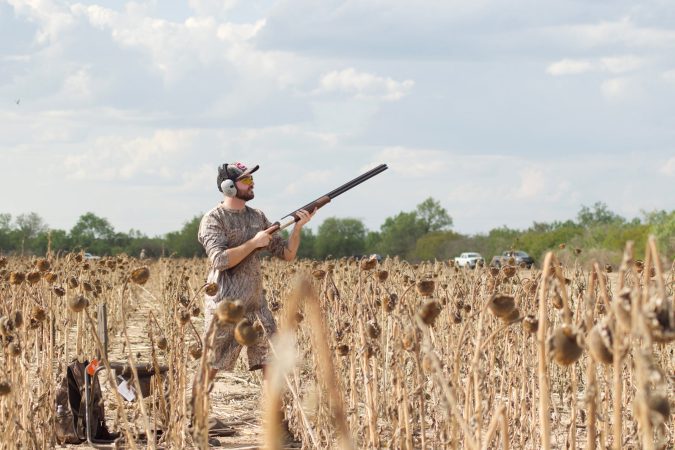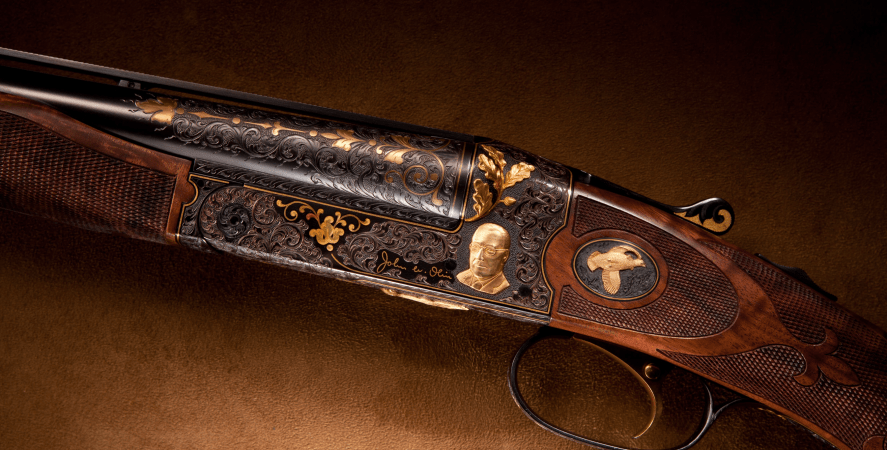We may earn revenue from the products available on this page and participate in affiliate programs. Learn More ›
The snow finally stopped, and the boy was ready. He knew the rabbits would come out to feed in the sunshine and leave tracks he could easily follow in the fresh powder. He carefully lifted the family single-shot shotgun from the wall pegs. The 12-gauge felt solid in his hands, and off he went in search of dinner.
That scene played out time and again on farms and country homesteads across America in the days when men and boys were tasked with bringing home wild game to feed their families. Money was tight for these folks, and they relied on affordable guns to supplement the food supply. Fancy side-by-sides and autoloaders were for wealthy city folks; country boys relied on a single shot to dispatch the critters they hunted.
Here are some of the most popular guns of a bygone era and a new version built to stand the test of time.
H&R Pardner and Topper

Gilbert Harrington made history in 1871 with his top-break, shell-ejecting revolver. He needed a partner with a production background to bring it to market and William Richardson fit the bill. They formed H&R in Worcester, Massachusetts, building iconic guns and a loyal following. They built solid revolvers and shotguns, soon becoming the only North American licensee for England’s Anson & Deely boxlock side-by-side shotgun.
But it was their single-shot shotguns that became synonymous with good quality at bargain prices. They called it the Pardner—and later the Topper—and produced it in every popular gauge from 10 to 28 and .410. Many young shooters got their start with this gun, although the light weight coupled with a hard butt plate didn’t exactly make it shooter friendly. H&R even made a cool little model called the Handy-Gun from 1920 to 1934 in .410 and 28-gauge. These little beauties could be had with 8- or 12¼-inch barrels—good for a home protection or a truck gun.

There was nothing fancy about the H&R single shots, but they did have color case-hardened receivers. On newer models, the action breaks open with a side lever positioned to the right of the external hammer. Older guns used a lever positioned behind the hammer. An ejector kicks spent shells from the gun, leaving an empty chamber ready for a fresh cartridge.
H&R formed a subsidiary, New England Firearms, and produced single-shots under that name as well. H&R has changed hands and restructured over the years, becoming H&R 1871 in 1991, bought by Marlin in 2000, and is now under the Remington name. Production of H&R guns ceased in 2015. Check availability here.
Winchester 37

One of America’s most iconic gunmakers is Winchester, and it figures they would recognize the market for an affordable workhorse shotgun. Enter the Model 37, a super strong and utilitarian single shot. Produced from 1936 to 1963, Winchester cranked out over 1 million 37s (all without serial numbers). The National Guard even put them into use during World War II, protecting warehouses, docks, and factories with 12-gauge models choked full with 30-inch barrels.
That same gun was a very popular choice among hunters across the country. You could buy one in 12-, 16-, 20-, and 28-gauge, plus .410, with long, tightly-choked barrels, although modified and cylinder options were available via special order. Ammunition then was not as powerful and effective as today’s offerings and most hunter’s preferred full chokes to deliver tight and deadly payloads. An exception was the upland hunting community, but a lot of farm boys and men didn’t waste ammo and time on small birds. They wanted at least squirrel-size game for the pot.

There are a couple notable distinctions with Model 37s offered in the “Red Letter” guns and “Boy’s” models. Prior to 1948, Winchester stamped its name on the guns and filled the letters with red enamel paint. So, that’s one way to tell early models from later offerings. The “Boy’s” model premiered in 1958 as a gun for new shooters. This 20-gauge sported a 26-inch barrel and a shortened stock fitted with a red Winchester logo recoil pad.
An interesting feature of the 37 is the low-profile hammer located behind the opening lever. This differed greatly from the H&R design and is sleeker and easier to use.
Iver Johnson Champion 36

Norwegian gunsmith and inventor Iver Johnson immigrated to the U.S., specifically Worcester, Massachusetts, during the Civil War. Johnson’s early claim to fame was in handguns and his revolvers became very popular pocket pistols.
While they produced single- and double-barreled shotguns as early as 1885, their most popular Champion model 36 single shots debuted in 1909 in 12-, 16- and 20-gauge with .410 following in 1916. All models were discontinued in 1957. These were your basic single-shot guns with the opening lever located behind the hammer, not in front like the Winchester 37. You could also buy Iver Johnson bicycles in those days. Ride your I.J. bike out to the hunting spot and use your I.J. shotgun to bring home the bacon. Pretty unique.
Another interesting feature on Champions were the serial numbers. Well, not numbers but coded letters. An example would be a gun with letters TCHB stamped on the barrel. The corresponding numbers are 3456 in the code. Seems random enough until you realize that the code for 1-9 is the word “Fitchburg.” That’s the name of the Massachusetts town the company moved to in 1891, becoming Johnson’s Arms & Cycle Works.
Iver Johnson is still around, selling shotguns and handguns built overseas in Turkey and the Philippines, respectively. They are based in Rockledge, Florida, a long way from their Massachusetts roots. And yes, they still make single-shot shotguns in .410 and 20-gauge in multiple configurations, including all-weather versions with synthetic stocks.
Henry USA Single Shots
The Henry name has been linked to firearms in the U.S. since 1860, when Benjamin Tyler Henry received a patent for his lever-action repeating rifle. That design was the basis for the 1873 and 1876 lever-action rifles later sold by Winchester.
Today’s Henry Repeating Arms only shares the name with the historic brand. Louis and Anthony Imperato bought the naming rights in 1996 and opened the factory in Bayonne, New Jersey, where the company remains today. Their bread and butter are still lever-actions in a dizzying array of models and calibers.
A couple of years ago they brought out both rifles and shotguns in single-shot configurations. The shotguns are available in 12- and 20-gauge and .410 in multiple platforms with either 28-inch (12 gauge) or 26-inch (20 and .410) barrels. Hunters and shooters can choose from walnut and blue steel with a rubber recoil pad, brass receiver and curved old-school butt plate or a new 12-gauge, 3.5-inch turkey model in full Mossy Oak Obsession camo (24-inch barrel). Hopefully they will add a 20-gauge turkey gun and maybe a .410 down the line. Modern tungsten super shot (TSS) loads have made both of those bores viable turkey slayers.
Deer hunters are not left out either, Henry added a rifled slug gun single shot to the lineup with a 1:35 twist rate. That’s perfect for slug stabilization, a key for turning a short-range shotgun into one capable beyond 100 yards. You can use fiber-optic open sights or an aftermarket optic (the receiver is drilled and tapped) for better accuracy.
Henry’s hammer setup is reminiscent of Iver Johnson’s with the opening lever directly behind the hammer. For safety, Henry added a modern hammer block system with a dual direction locking lever that does not allow the gun to fire unless the trigger is pulled. The action cannot be opened with the hammer back either. This lever setup also allows for ambidextrous operation, pushing the lever either right or left opens the slick action.
Outdoor Life is dedicated to covering safe and responsible gun ownership for hunting, recreation, and personal protection. We participate in affiliate advertising programs only with trusted online retailers in the firearms space. If you purchase a firearm using the links in this story, we may earn commission

















